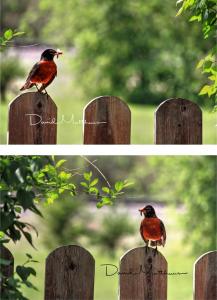Sale on canvas prints! Use code ABCXYZ at checkout for a special discount!

No idea why but when I show some of my photographs people ask “How long did it take you to take that photograph”?
Take a look at the photograph I took of the Robin on our gate. It took just 750th of a second to shoot that photograph, and days of watching listening and waiting, resulting in 5 great photographs.
Without thought and planning or a little luck any photograph is just a snap. Also if you edit a photograph too much it becomes just a picture. Whenever, wherever possible I try my best to edit in camera using an exposure often overriding what the meter says, and use filters on the lens to enhance when necessary.
I observed the two Robins over several days and sat on a bench with camera on a tripod so the Birds would be used to this, and when not observing put three pieces of wood in the same place as a substitute.
After time the birds grew used to this being there and I found their routine. The female would come through the hedge land on the ground see all was clear before flying to the nest to feed the chicks.
The male with bright red breast would fly onto the gate hop around look before flying into the nest. The time between each visit depended upon how quickly the birds found bugs. Their speed in catching and returning to the nest increase as the rain began and they mimicked the rain by trapping on the grass with their beaks as worms came to the surface.
I found they were happy with me sitting there provided I did not wear a blue and white striped shirt and black trouser, but preferred it when I wore pastel colours to blend with the house siding.
Several days went by without any photographs being taken, just observation and familiarity with their routine and they getting used to me, while I study and read up on Robins.
American Robins are common birds across the continent. You’ll find them on lawns, fields, and city parks, as well as in more wild places like woodlands, forests, mountains up to near tree line, recently burned forests, and tundra. During winter many robins move to moist woods where berry-producing trees and shrubs are common.
Female robins choose the nest sites, which are typically on one or several horizontal branches hidden in or just below a layer of dense leaves. Nests are typically in the lower half of a tree, although they can be built as high as the treetop. American Robins also nest in gutters, eaves, on outdoor light fixtures, and other structures.
Our pair chose an arbour covered with a Virginia creeper building the nest about 8 feet off the ground.
Early morning light is wonderful casting long shadows to add depth or highlight areas in this case the red breast and leaves. Patience timing and lighting all important and came together at 7am and I am not a morning person.
With my camera set on a tripod remote shutter release in hand and pre manually focuses in the gate all set up it was a waiting game. As always taking the photographs is such a thrill especially when the results turn out so well. More will be posted on http://davidmatthews.me and
https://www.instagram.com/atozillusions
There you will also see four chicks in the nest this was taken without disturbing them or annoying the parent bird.
Again observation and when both parents were well away from home I just sneaked into the arbour and with wide angle lens held the camera above my head took 2 photographs, then made my retreat to the safe place. The birds are still working hard feeding their young.